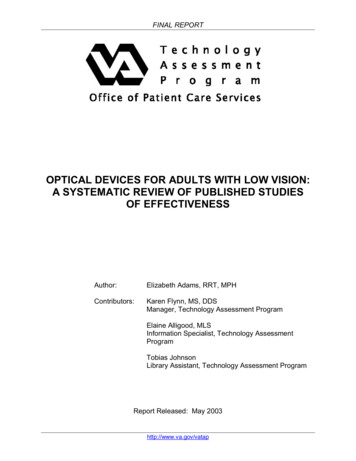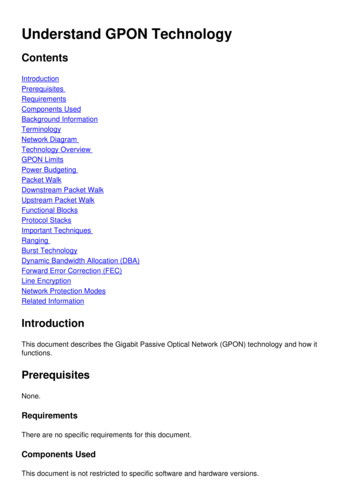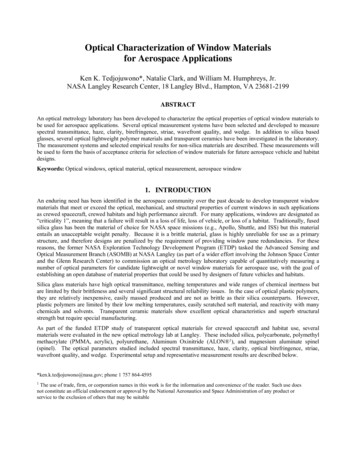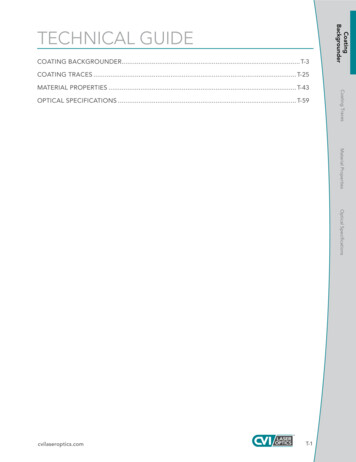
Transcription
FINAL REPORTOPTICAL DEVICES FOR ADULTS WITH LOW VISION:A SYSTEMATIC REVIEW OF PUBLISHED STUDIESOF EFFECTIVENESSAuthor:Elizabeth Adams, RRT, MPHContributors:Karen Flynn, MS, DDSManager, Technology Assessment ProgramElaine Alligood, MLSInformation Specialist, Technology AssessmentProgramTobias JohnsonLibrary Assistant, Technology Assessment ProgramReport Released: May 2003http://www.va.gov/vatap
OPTICAL LOW VISION DEVICES FINAL REPORTA SUMMARY FOR HTA REPORTSCopyright INAHTA Secretariat 2001The VA Technology Assessment Program is a member of the International Network of Agencies for Health Technology Assessment (INAHTA) [www.inahta.org]. INAHTA developed this checklist as aquality assurance guide to foster consistency and transparency in the health technology assessment (HTA) process. VATAP will add this checklist to its reports produced since 2002.This summary form is intended as an aid for those who want to record the extent to which a HTA reportmeets the 17 questions presented in the checklist. It is NOT intended as a scorecard to rate the standardof HTA reports œ reports may be valid and useful without meeting all of the criteria that have been listed.VA Technology Assessment Program ReportOptical devices for adults with low vision:A systematic review of published studies of effectiveness(MAY 2003)ItemPreliminaryYes1. Appropriate contact details for further information? 2. Authors identified? Partly3. Statement regarding conflict of interest? 4. Statement on whether report externally reviewed? 5. Short summary in non-technical language? Why?6. Reference to the question that is addressed and context of theassessment? 7. Scope of the assessment specified? 8. Description of the health technology? How?9. Details on sources of information? 10. Information on selection of material for assessment? 11. Information on basis for interpretation of selected data? What?12. Results of assessment clearly presented? 13. Interpretation of the assessment results included? What Then?14. Findings of the assessment discussed? 15. Medico-legal implications considered? 16. Conclusions from assessment clearly stated? 17. Suggestions for further actions? VA OPCS Technology Assessment Programhttp://www.va.gov/vatapNo
OPTICAL LOW VISION DEVICES FINAL REPORTACKNOWLEDGMENTSThe TAP gratefully acknowledges the contributions of the following reviewers.Participation as a reviewer does not imply endorsement.Valerie A. Lawrence, MDPhysician Advisor, VA Technology Assessment ProgramAudie L. Murphy VA Medical CenterAssociate Professor, Dept of MedicineUniversity of Texas Health Science CenterSan Antonio, TexasJohn Townsend, ODNational Director Optometry ServiceOffice of Patient Care ServicesVeterans Health AdministrationBaltimore, MarylandGary Mancil, ODChief, Eye Clinic & Coordinator, R&DHefner VA Medical CenterSalisbury, North CarolinaThe TAP wishes to acknowledge the following for their contributions to the report.John C. Whatley, PhDEducation Project ManagerVA Birmingham Employee EducationResourceBirmingham, AlabamaEllen MartinVisual Impairment Service TeamCoordinatorSeattle VA Medical CenterVA Puget Sound Health Care SystemSeattle, WashingtonWilliam R. De l'Aune, PhDPrincipal InvestigatorAtlanta VA Rehabilitation R&D CenterAtlanta, GeorgiaGregory L. Goodrich, PhDResearch PsychologistPsychology Service and Western BlindRehabilitation CenterVA Palo Alto Health Care SystemPalo Alto, CaliforniaMichael WeatherlyBlind Rehabilitation SpecialistAmerican Lake VA Medical CenterVA Puget Sound Health Care SystemTacoma, WashingtonVA OPCS Technology Assessment Programhttp://www.va.gov/vatap
OPTICAL LOW VISION DEVICES FINAL REPORTTABLE OF CONTENTSEXECUTIVE SUMMARY. iPURPOSE. 1BACKGROUND. 2Definition of low vision . 2Impact of vision loss on the visually impaired . 2Causes of vision loss in the veteran population . 3VA services for visual impairment. 4Demographics and trends in the veteran population. 4LOW VISION DEVICES INCLUDED IN THIS REVIEW . 7Special considerations for this review. 7USES OF LOW VISION DEVICES. 8Reading . 9Driving . 9MEASURING THE EFFECTIVENESS OF LOW VISION DEVICES . 10REGULATION AND REIMBURSEMENT OF LOW VISION DEVICES . 11Food and Drug Administration . 11VHA Reimbursement . 11Federal Medicare Reimbursement. 11METHODS . 11Scope of review . 12Search strategy. 12Other data sources . 12Inclusion criteria. 13Critical appraisal . 14RESULTS. 15Primary data–reading. 15Primary data–driving . 19Prior reviews of effectiveness of low vision devices or low vision rehabilitation. 19Limitations of this review. 21SUMMARY. 22KNOWLEDGE GAPS AND RECOMMENDATIONS FOR FUTURE RESEARCH. 23CONCLUSIONS AND RECOMMENDATIONS . 25END REFERENCES . 35Articles included for critical appraisal. 35Background articles . 35Excluded articles. 39VA OPCS Technology Assessment Programhttp://www.va.gov/vatap
OPTICAL LOW VISION DEVICES FINAL REPORTEXECUTIVE SUMMARY Vision loss in adults is associated with many comorbidities, activity limitations andlower quality of life. The prevalence of vision loss both in the general and veteranpopulations is projected to increase dramatically over the next 20 years. With thistrend is a growing need for low vision services targeted at detecting visualimpairment and mitigating the functional consequences associated with age-relatedvision loss to improve quality of life. Provision of low vision services, including low vision devices, to veterans is a priorityfor VA. Popular among veterans and practitioners are electronic optical devices suchas closed circuit TV (CCTV), computer assistive technologies, and non-electronichand held models. However, advocates for visually impaired veterans haveexpressed concern over the quality of scientific evidence supporting the use of manylow vision devices, particularly newly emerging electronic devices. A multidisciplinary task force of VA vision care experts has been charged withdeveloping a process for evidence-based new technology evaluation anddissemination of information in VA. To inform the task force, this systematic reviewidentified: 1) the existing evidence of effectiveness of optical low vision devices fromthe peer-reviewed published literature; 2) knowledge gaps, and; 3) evidence-basedtools for assisting data collection and clinical decision-making. This review reveals a paucity of high quality evidence in the peer-reviewed,published literature to inform choices about provision of optical low vision devices inVA. The best evidence consisted of seven small, prospectively controlled clinicalstudies comparing the performance of optical low vision devices for reading tasks atvarious distances in a controlled indoor setting. Evidence of preferences and usewere anecdotal. Sustained use of these devices in the subject‘s life setting,resources required in terms of costs and training associated with each alternative,and the link between device use and health related quality of life were unknown. In the absence of compelling evidence from published research and a standardtaxonomy of desired outcomes, clinicians must continue to rely on industry data,clinical observations, patient self-reporting, and real-world trials in determiningappropriate provision of low vision aids. Future research is needed to determine the appropriate candidacy for low visiondevices, suitable prescription of these devices, and outcome measures that definethe quality of life in subjects with age-related visual impairment along the continuumof visual impairment and disability. TAP encourages using an evidence-basedframework in evaluating evidence of effectiveness, partnering with industryand consumers to carry out evidence-based technology evaluation, andseeking out systematic information that can improve and standardize currentprescription practices.VA OPCS Technology Assessment Programhttp://www.va.gov/vatapi
OPTICAL LOW VISION DEVICES FINAL REPORTOPTICAL DEVICES FOR ADULTS WITH LOW VISION:A SYSTEMATIC REVIEW OF PUBLISHED STUDIESOF EFFECTIVENESSPURPOSEThe VA Technology Assessment Program (TAP) generated this systematic review inresponse to a request from VA Office of Patient Care Services (PCS) to evaluate theeffectiveness of low vision aids for the visually impaired veteran.VA is committed to rehabilitation of visually impaired veterans because of its ownmission and on behalf of stakeholders. The Blinded Veterans Association (BVA)1expressed concerns over the quality of the scientific evidence supporting the use ofmany low vision aids, particularly electronic devices that have emerged in recent years.Within VA, PCS and VA‘s Visual Impairment Advisory Board2 identified timely evaluationof technology as a priority area of service delivery. Finally, the VA Under Secretary forHealth identified visual impairment, including provision of low vision services, as animportant subject area for the Veterans Health Initiative.3VA clinicians and managers involved in care for the visually impaired veteran facerequests from veterans for new devices that are marketed without evidence ofeffectiveness, evaluation criteria or application. To develop a process for newtechnology evaluation and dissemination of information in VA, a multidisciplinary taskforce of VA vision care experts is being formed.Proponents of newly marketed products often advocate improvements over existingtechnologies. Choices about which technologies to purchase and use require evidenceof effectiveness relative to available alternatives. To that end, this systematic review willinform the task force in a number of ways: By identifying the current knowledge base in the peer-reviewed published literaturethat addresses the relative effectiveness of a wide range of optical low vision aids; By identifying gaps in the existing knowledge base from which recommendations forfuture research can be made; By recommending instruments and techniques to assist evidence-based datacollection and clinical decision-making.1BVA is a veteran service organization that provides access to information about new technologies,including education and awareness regarding efficacy, and advocates for all visually impaired individualswho rely on technology to function in their work and personal lives.2VIAB is a multidisciplinary panel of subject matter experts in eye care and blind rehabilitation withrepresentation from the field, Central Office, Veteran Integrated Service Network administrative andclinical leaders, and stakeholders.3Veterans Health Initiative is —a comprehensive program in VA to recognize the connection betweencertain health effects and military service, to allow veterans to document their military medical history, andto prepare health care providers to better serve their veteran patients, and to establish a database forfurther study.“ [http://www.va.gov/VHI/]VA OPCS Technology Assessment Programhttp://www.va.gov/vatap1
OPTICAL LOW VISION DEVICES FINAL REPORTBACKGROUNDDefinition of low visionWhile there is no universal consensus on a definition of low vision, generally low visionis thought of as vision loss that cannot be corrected medically, surgically or withconventional eyeglasses, and interferes with daily activities. The World HealthOrganization‘s definitions of the terms —disorder“, —impairment“, —disability“, and—handicap“ are used frequently in defining low vision and remedial services (Leat 1999).Disorder refers to the disease in terms of ocular pathology and etiology. Impairmentrefers to sensory deficit in the visual system, while disability refers to the inability toperform activities that are important to the person. Handicap relates to the economic,social or psychological changes incurred as a result of a visual impairment.Applying this construct to service delivery, Massof (1995) states that medical andsurgical interventions treat disorders to limit or reverse impairments, whereasrehabilitation enhances impairment to limit or reverse disabilities. Human servicesassist, accommodate, and educate persons with disabilities to limit or reversehandicaps. The goal of low vision rehabilitation, including provision of low vision devicesdiscussed in this review, is to ameliorate vision disabilities and improve the quality of lifeof these patients.In the US impairment-based definitions classified by performance on visual tests suchas visual acuity and visual field are commonly used to define low vision. According tothe International Classification of Diseases, 9th revision (ICD-9-CM), abnormal visionincludes five levels ranging from moderate low vision (20/80) to total blindness (no lightperception). The term —legal blindness“ is defined in the US as visual acuity of 20/200 orworse in the better eye with best corrective lens or visual field restricted to 20 degreesor less in diameter in the better eye (Public 2002). In practice, visual impairment canbegin to have a functional affect at approximately 20/50, which is roughly the size ofnewsprint, and many who are classified as legally blind may have residual vision andcan benefit from low vision services.Impact of vision loss on the visually impairedA growing body of research suggests a correlation between vision loss and a variety ofpatient outcomes. An analysis of data from the second Supplement on Aging, 1994(SOA-II) using an International Classification of Functioning, Disability and Health(ICIDH-2)4 framework showed that vision impairment among the elderly was associatedwith a variety of medical conditions (diabetes, arthritis, hypertension, heart conditions,stroke, osteoporosis, disorientation and confusion, depression, broken hips and historyof falls), activity limitations and participation restrictions (Crews 2001). Recent4ICIDH-2 is a conceptual framework that systematically groups functional states associated with healthconditions. It identifies three domains of human experience (body functions and structures, activity, andparticipation) and recognizes the role of the environment as a factor that enables and disables people(WHO 2001).VA OPCS Technology Assessment Programhttp://www.va.gov/vatap2
OPTICAL LOW VISION DEVICES FINAL REPORTobservational studies reported an association between visual impairment and increasedrisk of mortality (Wang 2001; McCarty 2001), falls and hip fracture (McCarty 2002;Ramrattan 2001; Lord 2001; Ivers 2000 (a); Klein 1998), depression (Rovner 1998;Brody 2001), and memory decline (Anstey 2001).Visual impairment in patients with glaucoma, age-related macular degeneration, anddiabetes was associated with decreased functional status, decreased self-reportedquality of life, and increased emotional distress (Stelmack 2001). Among patients withpermanent visual acuity loss due to age-related macular degeneration or diabeticretinopathy, utility values in terms of time trade-off were directly dependent on the levelof visual acuity in the better seeing eye caused by the disease, and not on the diseaseitself.Dual sensory impairment (vision and hearing loss) is a particular challenge for theelderly and their caregivers. To note, approximately 52% of veterans enrolled in VABlind Rehabilitation programs have some degree of hearing loss (VA BRS 2002).Recent cross-sectional research suggests a correlation between dual sensoryimpairment (visual and hearing) and a variety of health outcomes in the elderly, such ascomorbidities and greater difficulty performing activities (Campbell 1999), as well asfunctional status independent of either mental status or comorbid illness (Keller 1999;Reuben 1999). Evidence on the association between dual sensory impairment andmortality is inconclusive (Reuben 1999; Appollonio 1995; Laforge 1992).According to the Veterans Health Initiative Independent Study Course on VisionImpairment, the impact of vision loss on an individual‘s activities of daily living can bedramatic and affect the individual‘s social, familial, occupational, and recreational life(VHI 2002). Vision loss can change a person‘s ability to perform ordinary but importanttasks such as reading, driving, preparing meals, taking prescription medications, andmaintaining personal finances. Hobbies may end, and tasks such as correspondenceand facial recognition may be compromised. As a result, persons with vision loss canexperience less mobility and functional independence, and greater psychological stress,isolation from family and friends, risk of poverty, and potential loss of their homes.While the reasons underlying the correlations between vision loss and patient outcomesrequire further examination, the evidence suggests potentially far-reaching effects ofvisual impairment on the health and lives of the aged. A reasonable rationale can bemade for provision and evaluation of a full range of rehabilitation services to veteransusing frameworks that take into account the individual‘s age, overall health,performance of activities, social circumstances, and environment.Causes of vision loss in the veteran populationCauses of vision loss in the veteran population are primarily age-related (VA BRS2002). They are macular degeneration, glaucoma, diabetic retinopathy, and cataract.Of these, cataracts are commonly remediated through surgery. Other conditionsfrequently leave the veteran with visual impairment, which can be severe. Lesscommon causes found in the veteran population are cerebrovascular accidents, opticVA OPCS Technology Assessment Programhttp://www.va.gov/vatap3
OPTICAL LOW VISION DEVICES FINAL REPORTnerve disease (eg. multiple sclerosis), retinitis pigmentosa, and service-related injuriesor complications such as trauma and long-term effects of inhumane treatment ofprisoners of war.VA services for visual impairmentSince World War II VA has provided the only nation-wide comprehensive rehabilitationservice to American‘s blinded veterans and is recognized internationally as a leader inrehabilitation of the blind. The Blind Rehabilitation Service provides:— a continuum of care for blinded veterans extending from their homeenvironment to the local VA facility and to the appropriate rehabilitation setting.These services include adjustment to blindness counseling, patient and familyeducation, benefits analysis, comprehensive residential inpatient training,outpatient rehabilitation services, the provision of assistive technology, andresearch.“ (VA BRS 2002)VA offers a variety of low vision services to eligible veterans depending on the degree ofvisual impairment. VA enrollees or veterans who are legally blind and eligible for nonvision related VA health care services are eligible for a comprehensive array ofassistance through the VA Blind Rehabilitation Service. Visually impaired veterans whoexperience functional difficulties but are not eligible for blind rehabilitation may beeligible for assistance from low vision clinics at VA facilities, the Visual ImpairmentServices Outpatient Rehabilitation (VISOR) program, or the Vision Impairment Center toOptimize Remaining Sight (VICTORS) inpatient/outpatient programs.The Prosthetic and Sensory Aids Service (PSAS) furnishes blind aids and prostheticequipment related to sight loss to eligible veterans with visual impairment. For veteranswith visual impairment not caused as a result of active military service or with an incomeand net worth above established thresholds, co-payment for services is generallyrequired (DVA eligibility 2002).Demographics and trends in the veteran populationA VA national survey described the typical veteran receiving low vision services throughVA Blind Rehabilitation Services:—He is an elderly Caucasian male, who is married and lives in a home withhis wife. His visual impairment is due to macular degeneration, and hisvisual acuity is approximately 20/200. This typical veteran had a highschool education, and has now retired on an income that would place hisfamily in the lower middle class. The veteran is active, and participates insuch activities as socializing with friends, shopping for groceries, andparticipating in clubs or organizational activities.“ (Watson 1997(a))Between 2000 and 2020 the total population of veterans is projected to decline, but theproportion of veterans age 65 and older is projected to increase from 38% to 51%,VA OPCS Technology Assessment Programhttp://www.va.gov/vatap4
OPTICAL LOW VISION DEVICES FINAL REPORTrespectively (DVA 2000). Even more dramatic is a projected eight-fold increase in theveteran population age 85 and older during the same time period.There are currently over 93,000 legally blind veterans. Applying prevalence estimatesof legal blindness for specific chronological ages5 to the VetPop20016 veteranpopulation projections, by the year 2007, over 161,000 will meet the criteria for legalblindness, and over 1.2 million will have visual impairments including but not limited tolegal blindness (De l'Aune 2002).The VA Blind Rehabilitation Service has added outpatient rehabilitation services in theform of Visual Impairment Service Team (VIST) coordinators and Blind RehabilitationOutpatient Specialists (BROS) to meet the special vision needs of an increasinglyblinded geriatric veteran population. From Fiscal Year (FY) 1997 to FY 2000, thenumber of veterans served by VIST coordinators and BROS increased 16% (from30,313 patients to 35,172 patients) and 152% (from 873 patients to 2,199 patients),respectively (Beck 2001).Data from the PSAS National Prosthetic Patient Database from FY 1999 to FY 2001show a 7% increase in the number of discharges at Blind Rehabilitation Centers with acorresponding 23% increase in the number of aids furnished for the blind (Table 1).Table 1.National Prosthetic Patient Database: Blind aids furnished by PSASfrom FY 99 to FY 01FY 99FY 00FY01*BRC discharges1,7601,8171,885Aids for the Blind61,47772,56075,348stnd* Projected based on 1 & 2 quarters data5Center for Health Statistics, Health Interview Survey, Disability Supplement (1994-95) under fundingfrom DVA Rehabilitation Research and Development (C-2704-I "Secondary Data Analysis Relevant toLow Vision Rehabilitation“) and the DVA Visual Impairment Advisory Board.6VA‘s official estimate and projection of the number and characteristics of veterans based on Census1990 data, as of 9/30/01. Prepared by the Office of the Actuary, Office of Policy and Planning,Department of Veterans Affairs, April 2002. revalence estimates using VetPop2001Adj, VA‘s official adjusted population estimates based on Census2000 data were not available at the time this report was released.VA OPCS Technology Assessment Programhttp://www.va.gov/vatap5
OPTICAL LOW VISION DEVICES FINAL REPORTFigures 1 and 2 show that in FY 2002, several optical low vision devices were amongthe top 12 blind aids furnished to veterans in terms of either high unit costs (eg. 2,047CCTVs prescribed at an average unit cost of 2,047) or high prescribed volume (eg.21,524 hand held devices prescribed at an average unit cost of 75).Figure 1.National Prosthetic Patient Database: Top 12 Blind Aids by TotalCost (Raw Data) for FY 2002 4,500,000 4,000,000 3,500,000 3,000,000 2,500,000 2,000,000 1,500,000 1,000,000 500,000Figure 2.BA110 - RAZOR, ALLTYPESV2610 - SINGLE LENSSPECTACLE MOUNTBA185 - WATCH, ALLTYPESBA130 - TELEPHONEBA187 - LAMP, DESKBA118 CASSETTE/PLAYERRECORDERBA100 - READINGMACHINEV2615 - TELESCOP/OTHRCOMPOUND LENSBA101 - COMPUTERSOFTWAREV2600 - HAND HELD LOWVISION AIDSBA102 - COMPUTERHARDWAREBA107 - CCTV 0National Prosthetic Patient Database: Top 12 Blind Aids by TotalQuantity (Raw Data) for FY 200225,00020,00015,00010,0005,000VA OPCS Technology Assessment Programhttp://www.va.gov/vatapBA110 - RAZOR, ALLTYPESBA107 - CCTVBA118 CASSETTE/PLAYERRECORDERBA130 - TELEPHONEV2615 - TELESCOP/OTHRCOMPOUND LENSBA184 - CLOCKBA159 - PILL BOXBA162 - CANE, BLINDBA133 - GUIDE, WRITINGBA183 - EYEWEAR, SUNBA185 - WATCH, ALLTYPESV2600 - HAND HELD LOWVISION AIDS06
OPTICAL LOW VISION DEVICES FINAL REPORTLOW VISION DEVICES INCLUDED IN THIS REVIEWMost low vision devices (LVD) are designed to enhance access to information andensure safe mobility (Scherer 1996). A range of adaptive technologies for low visionexists in electronic and non-electronic forms from optical devices that incorporaterefractive correction and require prescription to non-optical devices.Optical devices are the subjects of this review because of their popularity amongVA patients and practitioners and their associated costs. An optical LVD is anydevice that alters the image focus, size, contrast, brightness, color or directionality of anobject through the use of lenses or other technology. Optical LVDs are intended: 1) toimprove visual acuity by enlarging images or by clarifying images through improvedillumination, color, or contrast enhancement, or 2) to enhance the field of view.In VA, such devices include, but are not limited to, spectacles with or without tint,microscopic spectacles7, hand held magnifiers, stand magnifiers, telescopes(monocular or binocular), head mounted lenses, minifiers8, prisms, and closed-circuittelevisions (CCTV) (DUSH 2000). This review will consider the full range of opticaldevices available to VA patients.Special considerations for this reviewIntraocular lens. Intraocular lens (or —implants“) are implanted surgically in patientswith cataract surgery to restore lost vision due to diseased tissue. Since this reviewfocuses on low vision aids used to optimize irreversible vision loss, these devices werenot included. However, individuals with implants may be included in studies in thisreview if they have persistent, irreversible low vision after surgery and are candidatesfor low vision rehabilitation.Contact lens. Occasionally, contact lenses are prescribed as an —add-on“ technologyfor veterans with vision loss (G. Mancil: personal communication July 18, 2002). Themajor use of contact lenses is to correct myopia, but other uses of contact lenses are: tocorrect hyperopia, astigmatism, presbyopia, aphakia, and irregular corneal surfaces; toprovide therapeutic protection for certain conditions, e.g. bullous keratopathy andrecurring corneal erosion; and to improve comfort, vision, and wound healing during thepostoperative period immediately following photorefractive keratectomy (Yanoff 1999).Contact lenses may be preferred purely for cosmetic reasons (eg. to avoid wearingspectacles or to change iris color). The two types of contact lenses are scleral andcorneal. Scleral contact lenses were developed first, but corneal lenses havesuperceded their use except for rare clinical conditions (Foss 1994).7spectacle-mounted lenses that exceed the upper power limit of standard reading glasses ( 3.50diopters) and generally range in power from 4.00 to 80.00 diopters; also called high-plus lenses, strongreading lens or high adds8devices that increase the amount of information in the visual field in proportion to minification (eg. a 2xminifier provides 2x more information in the visual field); visual scanning i
trend is a growing need for low vision services targeted at detecting visual impairment and mitigating the functional consequences associated with age-related vision loss to improve quality of life. Provision of low vision services, including low vision devices, to veterans is a priority for VA.











